Body-worn urine collection bags
Body-worn urine collection bags are also known as 'leg bags'.
Most bags are made of plastic and some have a fabric backing for comfort against the skin. They have a tube emerging from the upper side of the bag that connects to the funnel end of a catheter or sheath. At the bottom of the bag is a small tap or valve to allow emptying.
They can be worn discreetly under clothing and may be unnoticeable. Usually, they are secured to the thigh or lower leg, but bags are also available that may be worn around the waist.
1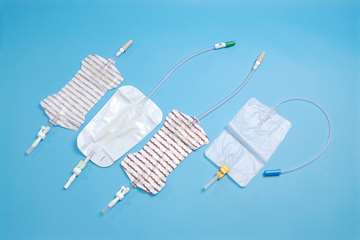
Body-worn collection bags - varied tubing lengthsWhen do body-worn urine collection bags work best?
Body-worn urine collection bags can be used at any time but are most useful during the day to allow ease of movement.
At night when greater capacity is needed, a large capacity bag can be connected to the body-worn bag. The valve of the smaller body-worn bag is left open so that urine can drain into the larger one. This is called a ‘link’ system.
For people who spend a lot of time in bed, a larger capacity bag connected directly to the catheter or sheath may be more convenient than a body-worn bag.
What about fitting?
Body-worn collection bags are generally easy to fit with reasonably good hand control and the ability to easily reach the legs.
Body-worn collection bags are usually secured to the leg with straps. They can also be held in place against the leg with an elasticated sleeve or suspended from a waistband. Special garments are also available that hold the bag in place - see Straps and support garments below.
The collection bag is connected by firmly pushing the tapered plastic fitting at the end of the collection bag tube into the funnel end of the catheter or sheath. The connection should be secure enough to prevent the collection bag tube from becoming disconnected.
It is important that the collection bag is held securely in place: a bag heavy with urine may pull down on the catheter or sheath if not properly supported. This can lead to disconnection and/or damage to the bladder neck. Using additional straps to secure the drainage tubing close to the leg above the bag can reduce this risk.
The collection bag should be positioned at a point lower than the bladder, to allow gravity to assist with the free flow of urine. When seated for long periods, this can be helped by securing the collection bag below the knee.123
What other products could ‘mix and match’ well with body-worn urine collection bags?
Some people manage successfully using only body-worn collection bags connected to a catheter or sheath.
However, others find using different product types at different times works best.4
When worn with a sheath, some men use a body-worn collection bag at certain times, such as when they are out and about, but use pads (instead of the sheath and bag) when at home or when in bed.
When using a catheter, some people use a catheter valve at times when they do not want to use a collection bag. The collection bag can be connected to the catheter valve, to maintain the closed link system, and removed when not needed.
Selecting body-worn urine collection bags
There is a wide variety of bags with different features available. The type of bag that suits people best is generally a matter of personal preference.5 The three factors that have been rated as being the most important by collection bag users are ease of emptying, comfort, and confidence that there will be no leakage.6
Which collection bag you use will be partly determined by local availability. To help you to think about what type of bag might suit you best, consider the following factors:
Capacity
Body-worn collection bags are available in different sizes: 250ml, 350ml, 500ml, 600ml, 750ml and (less commonly) 1000ml. Small bags tend to be more discreet under clothes but require more frequent emptying. As a guide, a bladder can generally hold 400-600ml of urine, so a 350ml bag may be insufficient to hold the contents of one full bladder. On the other hand, larger body-worn bags may be more noticeable under clothes and will be heavier when full, so that they may be more difficult to hold in place.
You may find that it helps to use different size bags at different times - you might prefer to use a smaller bag when you are out and about but a larger one when you are at home and discretion under clothes is not so important. Please note that when using with a catheter, the closed drainage system should be maintained.
Ease of emptying
Body-worn collection bags are emptied using a tap at the bottom of the bag. The design and performance of the tap is a factor that users consistently focus on. 6 Difficulties operating the taps and taps that open accidentally allowing urine to leak are the most common problems experienced by users.5
There are many different types of taps: some are opened by a sliding or twisting action, while others are opened using a small lever. Users report that some taps are harder to operate than others and urine can leak onto the hands during use.67 Taps with larger mechanisms may be easier to operate, but may also be more noticeable under clothing and more prone to opening accidentally if the mechanism is knocked or caught in clothing.
It may be worth trying different products to find one that suits you best. It may be helpful to consider the following:
- How easy it is to open/close the tap?
- Is the tap likely to be knocked or open accidentally?
- Can you empty the bag without urine wetting your fingers?
- How bulky/visible is the tap under clothes?
- How comfortable is the tap against your leg?
How you empty your bag may influence where on your leg the bag is secured. Some people find it more convenient to wear the bag higher on the leg and to lower their trousers for emptying. Others prefer to wear the bag lower on the leg and to raise the bottom of the trouser leg for emptying.
Comfort
Comfort can be affected by several factors: the collection bag itself, the method used to hold it in place, and the way it is connected to the catheter or sheath.
Most body-worn collection bags are made of plastic such as polyvinyl chloride (PVC), polyvinylidene fluoride (PVDF) or polyethylene. They can cause perspiration, and chafing resulting from movement of the bag against the skin has been reported.67 Some bags have a cloth-like backing which is intended to improve comfort.
Body-worn collection bags are most commonly secured to the leg with elasticated straps, which must be tight enough to support a full bag, and some people find this uncomfortable or ineffective. An alternative product is an elasticated support garment, which pulls on over the foot rather like a footless sock and provides a pocket which can hold a leg bag in place either on the thigh or on the lower leg. Straps and the net support garment can be used together for improved support.
11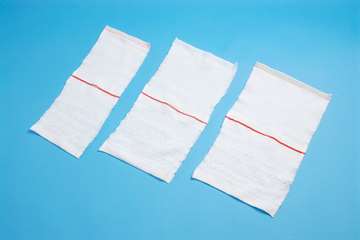
Collection bag support garmentsSome bags can be suspended on a belt fitted around the waist. However, these require a degree of bladder pressure to ensure urine passes into the collection bag and therefore are not suitable for everyone.
Another potential source of discomfort can occur when the drainage tube pulls on the catheter or sheath. The risk of this occurring can be minimised by making sure the bag is well supported and by using one or more tubing straps or devices to secure the connecting tube close to the leg above the bag.
Discreetness
Most people appreciate collection bags that are not easy to see or hear when worn.7 If you are experiencing problems, there could be another type available that may be more suited to your needs.
Smaller, body-worn collection bags tend to be more discreet under clothes, but need more frequent emptying.
2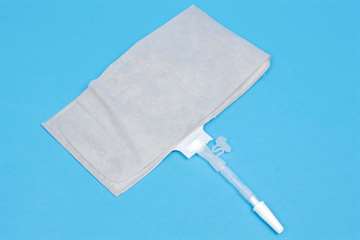
Small capacity body-worn collection bag The larger the bag, the more noticeable it is likely to be. The position of the bag on the leg may also have an impact on discretion. For example, if you wanted to wear a skirt or shorts you could attach the bag high up on your thigh or even use a bag suspended from the waist.
Most body-worn collection bags have a simple single chamber to hold the urine and these are more likely to bulge under clothing. Collection bags designed with internal welds that form several linked chambers effectively divide the urine into smaller quantities. This reduces the bulging and may also reduce any sloshing noise from movement of the urine in the bag. Fabric-backed bags and bags made from PVDF (Polyvinylidene fluoride) may be associated with less rustling noise than traditional PVC bags.
14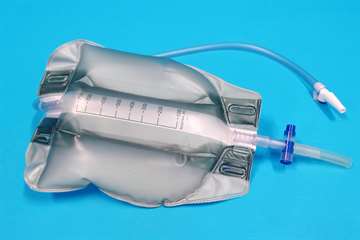
Multi-compartment body-worn urine collection bag Collection bags are usually available in neutral colours with faint text to reduce visibility through clothing. A collection bag and tubing which is well supported at top and bottom close to the leg will be less visible under clothing.
Positioning
Well considered bag positioning will assist with discreetness and effective drainage and collection of urine.
-
Collection bag design: Most body-worn collection bags are designed to be worn on the upper or lower leg. Bags which are shaped so that they can be worn on the leg alongside the knee joint are designed for wheelchair users or people who spend most of the time sitting. Other designs are available that can be worn suspended from the waist. There are abdominal “belly bags”, which may be a useful option for certain activities when you would like to avoid attaching a bag to your leg.
-
Relationship to the bladder: Generally, it is important that the collection bag is positioned lower than the bladder, so that gravity can assist the free flow of urine. If seated for long periods, try to position the bag below the knee to maintain drainage.123 Collection bags worn higher in relation to the bladder require a degree of bladder pressure to ensure urine passes into the collection bag and therefore are not suitable for everyone.
-
Tubing length: Body-worn collection bags are available with different tubing lengths, and some can be trimmed down in order to place the bag in the best position for you.
-
Bag emptying: The position of the bag on the leg will depend on your clothing and how you find it easiest to empty the bag. Some find it more convenient to wear the bag higher on the leg and to lower their trousers. Others prefer to wear the bag low on the leg and to raise the bottom of their trouser leg.
Sterile and non-sterile
Body-worn collection bags may be either sterile or non-sterile:
-
Sterile collection bags - should always be used with an indwelling catheter.
-
Non-sterile collection bags – are usually cheaper than sterile bags and can be used with a urinal or, by men, with a sheath.
Changing bags
If your collection bag is attached to an indwelling catheter (as opposed to a sheath), you should avoid changing the bag unnecessarily as this will break the closed drainage system. You should discuss this aspect of catheter care with your health care professional.
It is usually recommended that collection bags are changed every five to seven days.3 This is generally based on the manufacturers' guidelines and expert opinion. Currently there is little research evidence to suggest that they should be changed more or less frequently.
If you have an indwelling catheter and must disconnect it from the collection bag, for example to change the bag, good hygiene should be practised:
- Wash your hands thoroughly before touching the connection.
- It is a good idea to clean the connection thoroughly before disconnecting, preferably with alcohol wipes.
- Reconnect as quickly as possible.
- Wash your hands thoroughly after disconnecting.
If your catheter and collection bag become disconnected accidentally:
- Wash your hands thoroughly before touching either the catheter or the collection bag tube
- Clean the ends of the catheter and the collection bag tube thoroughly
- Reconnect as soon as possible.
Reusing bags
Reuse of body-worn collection bags is not recommended. However, it is known that catheter users who have to purchase their own bags do use them for longer than the recommended period and wash and re-use them. A study of vinyl leg and night bags found no difference in bag and urine culture contamination rates, when bags were cleaned with a dilute bleach solution (1 in 10 sodium hypochlorite) daily for a 4-week period compared to bags that were cleaned daily, but changed weekly.8
There is no evidence that the practice of adding antiseptic agents to drainage bags reduces bacteriuria or catheter-associated infection.9
Where can I get body-worn urine collection bags?
The cost of collection bags varies according to the type and which country you live in. If you live in the UK, then you will be able to get them prescribed from the family doctor. In some other countries such as the US, depending on your insurance programme, it may be possible to get reimbursement. Speak to a healthcare professional for local advice in your country.
| Suppliers | Availability |
|---|
| Clinimed | Worldwide |
| Clinisupplies | Europe |
| Coloplast | Worldwide |
| Convatec | Worldwide |
| DIB International | Europe, Americas, Asia |
| Flexicare | Europe, Americas, Asia, Oceania |
| Hollister | Europe, Americas, Asia, Oceania |
| LinC Medical | Europe |
| Manfred Sauer | Europe |
| Optimum Medical | Europe, Americas, Oceania |
Straps and support garments
13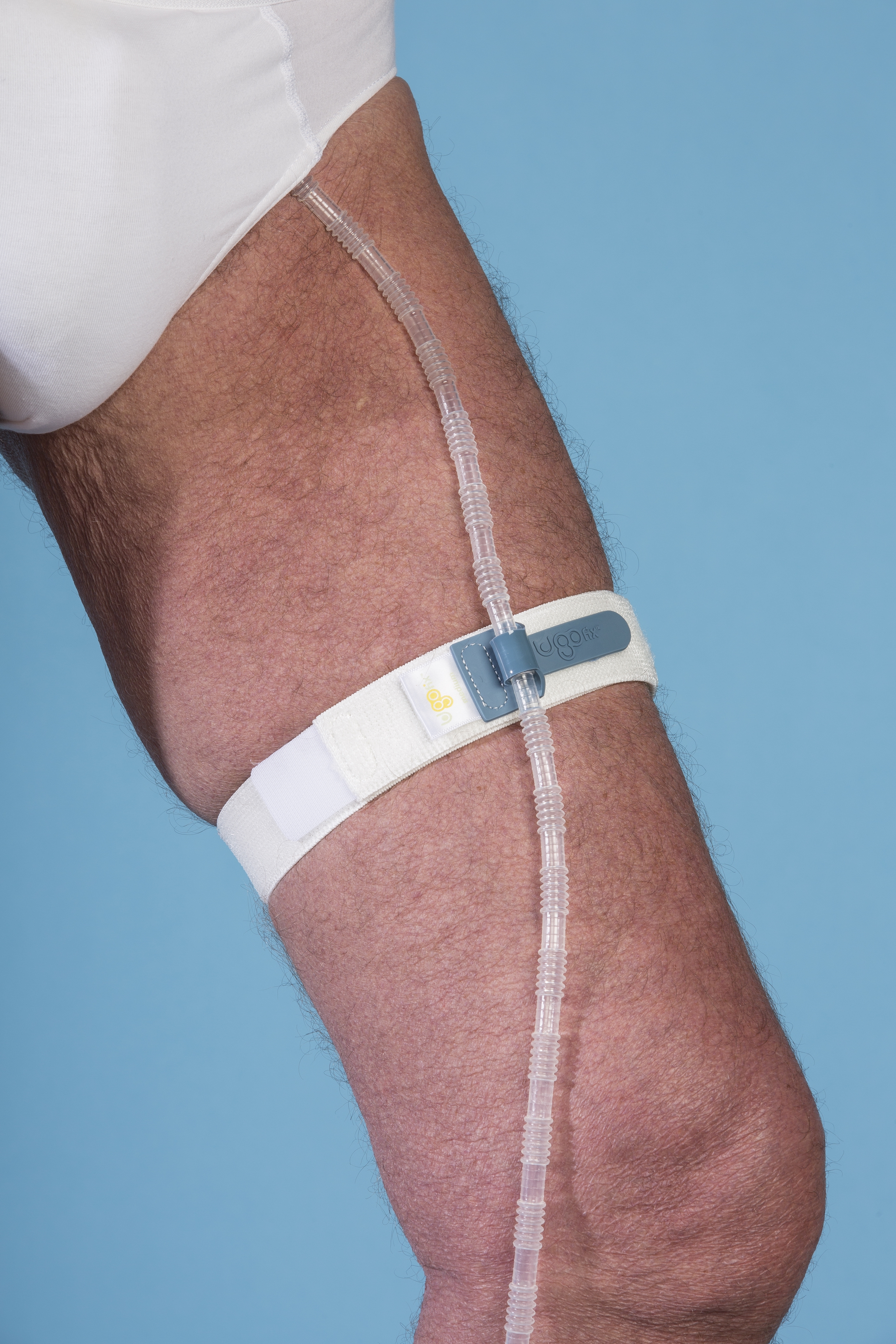
Fixation strap for collection bag tubing or catheterWhen considering how you want to secure your collection bag in place, there are several points that it may be helpful to consider:
- How difficult straps or other support devices are to put on and take off
- Comfort when the bag is in place
- Discreetness under clothes
- Cost and how long they can be reused for
- If you are a catheter user, it may also be worth considering a stabilisation device to hold the catheter in place, reducing the risk of the leg bag pulling downwards on the catheter - click on catheter accessories for more information.
Straps
Body-worn collection bags are most commonly secured to the leg with elasticated straps, which are normally supplied with the bags. Usually, one pair of straps per box of leg bags is provided. They can be washed and reused several times.
The straps are passed through slots on the upper and lower edges of the bag, passed around the leg, and fastened with buttons or hook-and-loop fasteners (Velcro).
Many straps have silicone on their inner surface to improve grip.
Net support garments
Another product that can be used to hold the bag in place is an elasticated support garment, which pulls on over the foot rather like a footless sock, and provides a pocket which can hold a leg bag in place either on the thigh or on the lower leg.
The lower seam of the pocket has a slot through which the drainage tap of the collection bag can be passed for emptying.
Suspension garment
This is a belt that fits around the waist from which a collection bag can be suspended. This type of system usually has a bag specifically designed to fit on the suspension garment.
Where can I get straps and support garments?
How you get these products and where they are available varies according to local healthcare systems. Speak to your healthcare professional or contact the supplier using the links below to find out how to get them where you are. Companies that supply body-worn bags provide straps with them. Generally, companies that provide collection bags also provide appropriate support garments.
Large Capacity Urine Collection Bags
Large capacity collection bags are usually positioned away from the body on either a floor stand or a hanger that hooks onto a bed or chair frame. They are commonly called night bags.
They are much larger than body-worn collection bags with a capacity of 2000-4000mls (approximately 3.5-7 pints).
Single-use versions have a tear-off portion or single-use tap to allow emptying of the urine before disposal. Reusable ones have a drainage tap like a body-worn collection bag and are washed out between uses. They can typically be used for 5-7 nights before being replaced.
Glass and plastic (PVC or HDPE) bottles are available but are less commonly used. They are suitable for high volume or overnight urine drainage, are reusable and the manufacturers recommend a purpose-made urological appliance cleaner such as Urolux.
9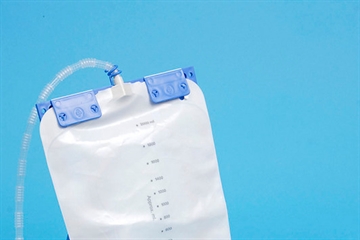
large capacity collection bag and stand Who are large capacity urine collection bags good for?
Larger capacity urine collection bags are most often used day or night by people who are immobile and/or in bed for long periods. They can also be used during the day by wheelchair users; the collection bag connected directly to the catheter (or sheath), without the need for a body-worn bag.
When do large capacity urine collection bags work best?
They are most useful to manage large volumes of urine either on their own or when connected to a body-worn bag. This 'link system' is useful during the night as it avoids the need for repeated emptying of smaller bags. The large collection bag should be connected directly to the tap of the smaller bag, and the tap left open, so urine can drain from the smaller to the larger bag. This minimises the need for repeated connections and disconnections between the tubing and the catheter, thereby reducing the risk of infection.4
What about connecting and positioning?
Large capacity urine collection bags are usually suspended on either a floor stand or a hanger that hooks onto a bed or chair frame.
It is especially important that the tap is supported clear of the floor to reduce the risk of cross-infection.123
Loops, curves, kinking and twisting of tubing should also be avoided. See Maintaining free flow below.
Where can I get large capacity urine collection bags?
The cost of collection bags varies according to the type and which country you live in. If you live in the UK, then you will be able to get them prescribed from the family doctor. In some other countries such as the US, depending on your insurance programme, it may be possible to get reimbursement. Speak to a healthcare professional for local advice in your country.
Hygiene and infection control
Many aspects of hygiene and infection control apply to both body-worn and large capacity collection bags.
Prevention of infection is of paramount importance to collection bag users, particularly those who are using them in conjunction with an indwelling catheter.
It is useful to understand the difference between the use of a urine collection bag with a sheath and with an indwelling catheter:
-
An indwelling catheter passes from outside the body into the bladder and potentially provides a route for bacteria to enter. To reduce the risk of infection, the catheter and collection bag are intended to be a closed, one-way drainage system. The connection between the catheter and collection bag is watertight, and collection bags have non-return valves that prevent urine from flowing back along the catheter and into your bladder. This helps to reduce the risk of infection because there is little or no opportunity for air or liquids from outside your body to travel into the bladder.
-
A sheath, on the other hand, is an external collection device. Men who use sheaths have the natural defence against external infection provided by the urethra, which is constantly flushed as urine passes out from the bladder. Men who use them change their own sheaths and collection bags as needed. Maintaining good hygiene is still important, though.
Reducing the risk of infection
Collection bags have various features intended to reduce the risk of infection:
-
A non-return valve where the urine enters the bag prevents back-flow of urine up the tubing when the bag is moved by users or carers.
-
Bags whose tap and outlet tube are widely separated are thought to be most effective at preventing contamination of the leg bag spouts.10
-
Many body-worn bags have an emptying tap with an outlet sleeve that allows it to be connected to a larger overnight bag. The outlet tap of the body-worn bag is left open so that urine passes through it to the larger bag. This is called a ‘link’ system and as it minimises the times that the collection bag and catheter are disconnected, is important for reducing the risk of infection
-
The end of the connection tube of a large capacity bag normally has a dust cover. When the large collection bag is disconnected from the tap of the body-worn bag, for example in the morning, the connector of the large bag should be cleaned and the dust cover replaced. The tube should be coiled, covered and stowed with the bag off the floor ready for re-use.
If you have an indwelling catheter and need to disconnect it from the collection bag, for example to change the bag, good hygiene should be practised:
- Wash your hands thoroughly before touching the connection.
- It is a good idea to clean the connection thoroughly before disconnecting, preferably with alcohol wipes.
- Reconnect as quickly as possible.
- Wash your hands thoroughly after disconnecting.
If your catheter and collection bag become disconnected accidentally:
- Wash your hands thoroughly before touching either the catheter or the collection bag tube.
- Clean the ends of the catheter and the collection bag tube thoroughly.
- Reconnect as soon as possible.
Urine sampling
Sometimes it is necessary to take a sample of urine from the catheter for analysis. Some bags have a special sampling port in the inlet tubing of the bag from where a urine sample can be obtained in a way that minimises the risk of micro-organisms entering the catheter and bladder. Some of these ports require a needle and syringe, whereas others require a syringe only.
Purple bag syndrome
There are occasional reports from healthcare professionals of purple discolouration in collection bags, which is often called purple urine bag syndrome. It is thought that this occurs in users who have highly alkaline urine (high pH) and high bacterial counts.1112 There is no evidence to suggest that it has a negative effect on a user's health or functioning of the bag/drainage system, although there may be an associated unpleasant smell.
Maintaining free flow
It is important that urine can flow easily from the bladder, through the catheter and into the collection bag. For people with indwelling catheters, if the free flow is reduced or stopped, there is a risk of urine building up in the bladder and the associated risk of infection.123
For men using sheaths, a reduction or blockage of the flow of urine can lead to urine building up in the sheath. This can lead to leakage and disconnection.
An over full collection bag will always prevent the further flow of urine. Whenever possible, collections bags should be emptied when they are half or three quarters full.
A number of other factors can prevent free flow of urine, and there are some precautions that can be taken to prevent these:
Avoiding kinking or twisting
If the connection tubing, catheter or sheath become kinked or twisted, the free flow of urine can be impaired or even stopped. Some collection bag tubing is corrugated or spiral-shaped to prevent kinking. Research suggests that tubing diameters could be reduced without compromising the flow rates for leg bags, and this may reduce the likelihood of tube kinking.13
5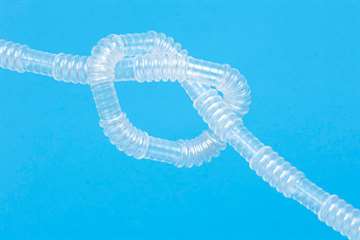
Corrugated anti-kinking collection bag tubingGood positioning is important to allow these components to lie flat against the body with enough slack for movement but no excess. Use of tubing support straps or stabilisation devices help to prevent pulling on the catheter (or sheath). Men may need to consider the effect of penile erection when securing catheter tubing and a collection bag in place.14
Loops in connection tubes
Sometimes loops or curves that fill with urine can form in a collection bag tubing. This is especially common where large collection bags with long tubing are used by people in bed but can also occur with body-worn bags. Research has highlighted that fluid-filled loops or curves in connecting tube can reduce or even prevent the flow of urine to the collection bag. 1516
To prevent loops forming use collection bags with the correct inlet tube length or those that can be trimmed to the length you require. If using a large collection bag, adjust the position to minimise loop formation.4